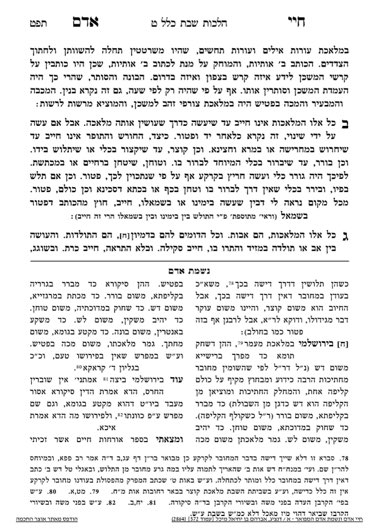We are continuing in siman 2, where the Chayei Adam is discussing melachos performed with a shinui. We left off learning that a melacha performed in a not-normal fashion is not chayav. The Chayei Adam gives some examples:
Digging a hole, which is the melacha of choreish, is not chayav mideoraysa until one uses a utensil normally used for plowing or digging a hole, such as a plow, shovel or pickaxe.
One will not be chayav mideoraysa for kotzair unless they use a utensil normally used for kotzair, or they cut it with their hand. If one bites it off the vine directly, they will not be chayav mideoraysa.
One is not chayav for borer unless they use a utensil, since borer is generally performed with a sifter or sieve. If one, for example, uses a funnel to separate between wheat kernels and chaff, such that when the funnel is rotated, the kernels fall to the ground and the chaff remains in the funnel, they are not chayav mideoraysa. If one uses their own hands, in most cases they will not be chayav deoraysa.
Tochein is generally performed with a mill or mortar and pestle. If one uses other items, such as the back of a knife, it may accomplish the same goal, but it is in abnormal use, and is not chayav mideoraysa.
The Chayei Adam is careful to write that in all of these cases, one is patur–he does not write that it is muttar (we will return to this point later).
He also writes that performing these melachos with one’s other hand is not a shinui, because many melachos can be performed with either hand. The only exception is kosaiv, where writing with the other hand is considered a shinui and makes one patur mideoraysa.
To explain, we learned yesterday that even when the result of a melacha is the same, when it is performed in an abnormal manner, it will still be patur mideoraysa. However, we need to define what is considered an abnormal manner. For example, if one turns on a switch while doing a handstand, although it is strange, the handstand has nothing to do with the act of melacha, so it is not a shinui.
Therefore, performing melacha with one’s other hand does not generally constitute a shinui, because the shinui is irrelevant. On the other hand, when it comes to kosaiv, writing with the other hand is more laborious, and the result is less professional, so it does constitute a shinui. We will discuss this further in the upcoming shiur, be’ezras Hashem.
Summary
Melacha done in an abnormal fashion, even if the result looks normal, is patur. This is known as melacha done with a shinui or melacha done ki’lachar yad.
Patur does not mean muttar.
A shinui must be inherent to the actual melacha performed, and not just an additional component happening at that time.



